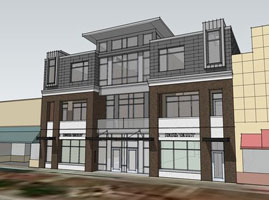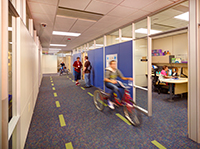view all Case Studies
CMMS Helps Development take 'LEED' on Maintenance

While a basement boiler may keep tenants warm in a typical apartment building, the residents of a unique complex in Kalamazoo, Mich., draw heat from a source far from their third-floor luxury lofts.
March 14, 2014 -
Software
While a basement boiler may keep tenants warm in a typical apartment building, the residents of a unique complex in Kalamazoo, Mich., draw heat from a source far from their third-floor luxury lofts. In fact, the award-winning Corporation Hall building taps into a geothermal heat sink housed in 18 vertical bores that reach down 400 feet below the earth’s surface.
The bores were drilled at the site during construction and renovation of the historical building, and the geothermal system is only one of several energy-efficient components at the mixed-use complex. The property, developed by real estate holding company Catalyst Development, also features low-flow toilets, LED lights, Energy Star appliances, and a rooftop solar system that preheats the domestic hot water, all of which contribute to LEED certification, which the company is pursuing.
Though construction practices have a big impact on achieving LEED certification, it is just as important for developers to operate their buildings to maintain sustainability standards throughout the life cycle of their projects. To support the full array of green building equipment, property superintendent Morgan Macomber depends on a scalable computerized maintenance management system (CMMS) that can handle all tasks for Corporation Hall and five other properties in Catalyst’s portfolio. Macomber employs Bigfoot CMMS, a cloud-based solution from Smartware Group, Inc. that touts powerful functionality coupled with intuitive design, for maintenance management across all six buildings.
“Applying for LEED certification requires us to operate our building in the same way we built it,” Macomber says. “For instance, since we started with LED lights, we continue to use them. Bigfoot helps us monitor those lights and track inventory for replacing them as needed.”
The geothermal pump is modulated through a control panel to keep it running at the precise capacity needed to reduce energy consumption. The pumps in the building require regular preventive maintenance to avoid system malfunctions.
“Another way we use Bigfoot is to alert us when it’s time to carry out preventive maintenance tasks on the geothermal and associated pumps, and other green energy equipment,” Macomber says. “We have the geothermal system, plus chillers, cooling units, air handlers and all the other systems needed for commercial and residential tenants.”
Designing the 146-year-old building for mixed use seems fitting it once served as Kalamazoo’s first city hall, as well as a fire station and department store. In addition to the apartments on the second and third floors, the building houses a drug store at street level that uses the basement of the building for specialty pharmaceutical production. This type of complex promotes energy efficiency on a community-wide scale because it offers downtown residents an alternative to driving their cars on long commutes.
During construction, Catalyst also made efforts to reduce waste and energy use by working with Kalamazoo’s Heritage Company to salvage historic architectural elements at the site, and by recycling building scraps to keep them out of landfills.
The ability to transfer effective practices from one building to another is one feature Macomber appreciates about Bigfoot, since his group is responsible for maintaining more than 300,000 square feet at six properties. “If I have a new tenant in the building, I can add that apartment and all its equipment to Bigfoot,” he said. “The program has scalability, so it doesn’t matter how much equipment we put in Bigfoot — we can add as much as we want. And we’re entering new equipment all the time.”
Likewise, commercial tenants can directly alert the maintenance staff about problems. Authorized tenants can log on to Bigfoot from their computers and submit a request to repair a thermostat, replace a bulb, or other similar maintenance tasks.
Maintaining a property with complex equipment can seem like a never-ending job. But Macomber observed that Bigfoot makes it possible for him to keep closer tabs on completed tasks. “Before using Bigfoot, we used e-mails and phone messages,” he said. “But there was no tracking. It was easy to do something but then forget to close out the work order.”
“Now I get an e-mail notification when a work order is complete,” Macomber said. “With Bigfoot I know my job is done.”
Next
Read next on FacilitiesNet












